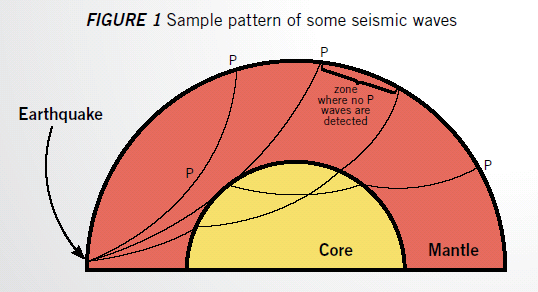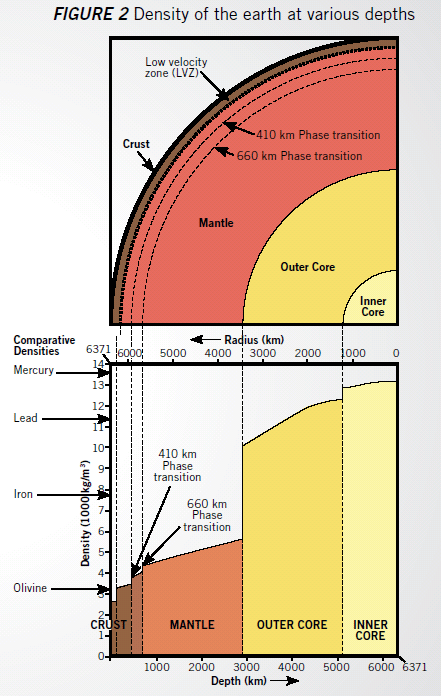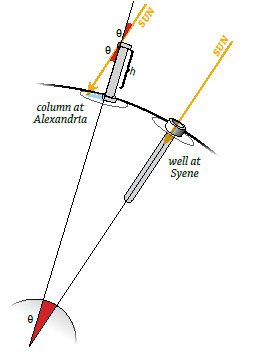Journey to the Center of the Earth
So much about earth history depends on a correct understanding about the inner workings of our planet. But how can we know anything about the earth’s interior since we can’t actually go there and see it firsthand?
Jules Verne captured imaginations in 1864 with his epic science fiction novel A Journey to the Center of the Earth. Despite huge technological advances, such a journey would be impossible, not because we lack interest but because the earth isn’t hollow.
How do we know this? In fact, how do we know anything about the earth’s interior?
This question isn’t trivial. Our modern economy depends on a correct understanding of the earth, as we incessantly search for oil and essential minerals, and predict deadly earthquakes or volcanic eruptions. Moreover, the modern debate about the origin of the solar system and the universe revolves, in part, around what makes up the earth’s interior and the dynamic forces that shaped and moved the continents.
Drilling alone can’t tell us much. Until recently the deepest drill-hole, the Kola Superdeep Borehole in Russia, reached a depth of 7.6 miles (40,230 feet, or 12,262 m). This impressive feat took nearly twenty years (1970–1989). Oil wells drilled in Qatar in 2008 and 2011 reached only a few hundred feet (tens of meters) deeper, but these are all still pin pricks compared to the 3,960 miles (6,371 km) to the earth’s center.
The Size and Density of the Earth
The earth’s vast size is hard to imagine. Yet humans have known about it since early times. Pythagoras (about 530 BC) was probably the first to recognize that the earth is a sphere.1 By sitting at the harbor and observing the approach of ships from beyond the horizon—first the masts and sails, and then the hull peeped over the horizon—he realized that the earth’s surface must be curved.
Eratosthenes (276–196 BC), chief librarian at Alexandria in Egypt, devised a simple and elegant method for estimating the size of the earth and the distance to its center, without the need to travel around the world (see sidebar for details). He calculated the earth’s circumference to be approximately 25,000 miles (40,234 km), only 2% above the actual value.
Isaac Newton furthered our knowledge of the forces holding the earth together when he formulated the law of gravity. All the particles of the earth are pulled toward the center of gravity, and the spherical shape is the natural result.
These principles are necessary to help us investigate the composition of the earth. What kinds of materials—light or heavy, liquid or solid—fill this sphere? To begin, we must establish three basic facts: volume, mass, and density.
Volume
Volume is easy to calculate. We know the “space” inside a ball simply by knowing its circumference. The earth’s circumference has been confirmed by surveying measurements, both on the earth and from space. The earth is not quite a perfect sphere, but we can still easily calculate its circumference and volume.
Mass
The mass of the earth—the amount of matter it contains—is a little tougher to find. It can be estimated from the orbital period of the moon (the time it takes the moon to complete one orbit around the earth).
Density
We can calculate the earth’s density by dividing the mass by the volume. This gives us a hint about what kind of materials are inside the earth. We simply need to compare this density to the densities of typical rocks we find on the surface.
Typical rocks have densities of about 156–187 pounds per cubic foot (2.5– 3.0 grams per cubic cm). Yet the earth’s density is much higher—an average of 343 pounds per cubic foot (5.5 grams per cubic cm). How then can we reconcile these different values?
Not Just Compressed Rock
With increasing depth, the pressure within the earth becomes immense. The temperatures also increase. The weight of the overlying rock compresses the interior, which increases the density.
We can measure this effect in the laboratory. Yet if we compress surface rocks to pressures equivalent to the earth’s interior, we still do not obtain the same high density.
So we have to conclude that the earth is not made entirely of rock. The material deep within the earth must have a much higher density than simply that of compressed rock.
Evidence from Seismic Waves
We can learn something about a body of material by the way certain waves pass through it. Such waves pass through air, water, or molasses in different ways.
An earthquake generates seismic waves that can travel all the way through the interior of the earth. It is somewhat similar to a pebble dropped into a pond. The waves emanate in circles out from the point of impact and are clearly visible. The sound waves that we generate in the air when we speak are similar but invisible. Seismic waves in rocks are similar to the invisible sound waves in the air.
As seismic waves travel through the earth away from an earthquake, they eventually reach the earth’s surface again where they can be detected (Figure 1). We can then use them to probe the earth’s interior in a way similar to how x-rays reveal our internal anatomy.
By analyzing these seismic waves, researchers have constructed a model of the earth’s interior (Figure 2). At a depth of about 1,796 miles (2,890 km)—about 2,163 miles (3,481 km) from the center of the earth—an abrupt change in the behavior of seismic waves indicates that there must be a sudden increase in the earth’s density. This corresponds to the core-mantle boundary.
Evidence of the Core from Seismic Waves
Earthquakes generate various seismic waves (such as P-waves) that travel through the earth’s interior. By analyzing how these waves change behavior when they reach different regions, we can learn where the density changes significantly. At a depth of about 1,796 miles (2,890 km), an abrupt change indicates a sudden increase in density. This corresponds to the core-mantle boundary.
If we look at a chart of different metal densities, iron best fits the density at the core, and olivine (a magnesium-iron silicate mineral) best fits the mantle. Even though the core is made of the same basic iron material, certain seismic waves travel differently through the outer core, indicating that it must be liquid, while the inner core is solid.


Iron fits this estimated density and behavior. Iron would also explain the earth’s magnetic field. If a small amount of nickel is added to the iron, the earth’s overall density almost perfectly matches the earth’s average density.
Even though the core is made of the same basic material, it appears that it is divided into two parts: an outer and an inner core. Certain seismic waves travel differently through the outer core, indicating that it must be liquid, while the inner core is solid.
Volcanoes—Windows to the Earth’s Interior
We learn other clues about the interiors of continents by the materials that volcanoes belch out. As molten rock passes through the earth’s deep continental crust, chunks of rocks are broken off. When the lavas erupt and cool, many of these chunks remain intact.
The basalt lavas that picked up these chunks of continental rocks on their way to the earth’s surface are a different kind of material. So they must have a different source below the crust, from the uppermost mantle. This is consistent with the seismic evidence. Sometimes these basalt lavas also bring up chunks of uppermost mantle rock.
Another confirmation that we are looking at upper-mantle rocks is the rare occurrence of diamonds in them. Inside the earth, diamonds are stable at depths greater than 100 miles (160 km). The conditions at shallower depths can actually turn diamonds into graphite! That means the likely source of these diamond-bearing rocks is at least 100 miles down in the upper mantle. Their composition confirms what we expected the upper mantle to be like.
Evidence from the Earth’s Wobble
Another clue about the earth’s makeup is its wobble. The earth spins like a top, with its spin axis tilted at 23.5°. This spin causes it to bulge slightly (by 13 miles [21 km]) at the equator and to contract a little at the poles. So the earth wobbles as it spins.
This wobble occurs in a predictable pattern. If the “top” were made out of the same material throughout, it would theoretically take about 31,500 years for the earth’s wobbling axis to complete one full circle. But instead, we can calculate that it would take only 26,000 years (and, based on Scripture, the earth hasn’t been around that long).
By measuring the earth’s wobble and bulge, and estimating the forces of gravity exerted by the sun and moon, it has been shown that material in the earth’s interior must be much denser than that on its surface. Iron in the earth’s core helps explain these observations.
Evidence from Meteorites
Another hint of the material within solid planets comes from out in space. Between Mars and Jupiter is the asteroid belt, which contains rocky objects ranging in size from less than an inch (mere millimeters) to several hundreds of miles (or kilometers) across. Collisions in the asteroid belt cause fragments of asteroids to be ejected from their orbit into a collision course with the earth. Entering earth’s atmosphere, most asteroids burn up, forming meteors or shooting stars. Those fragments that reach the earth’s surface are called meteorites. Most meteorites (but not all) are believed to have come from the asteroid belt.
Stony meteorites constitute almost 95% of catalogued meteorites. The major mineral in them is olivine. This is the same major component in the chunks of mantle rock brought up to the earth’s surface. Just over 4.5% of meteorites are irons. They consist of iron-nickel alloys, which match the composition of the earth’s core deduced from other evidence.
Secular astronomers generally claim the asteroid belt is leftover materials from when the solar system formed. The Hebrew words used in the creation account might indicate that on the fourth day, God formed the planets from matter that He had already created earlier. If this is the case—and we do not know for sure—the asteroid belt may be “leftovers” from that process, and asteroid fragments that fall to earth as meteorites may provide us with samples of the possible internal composition of rocky planets.
Conclusion
We can better understand the forces that shaped and moved the continents during the Flood.
While we cannot directly sample deep inside the earth, researchers can use several lines of evidence together to provide a confident answer to our question—what is inside the earth? Our best scientific estimates are that beneath the outer skin, called the crust, is a rocky mantle composed primarily of olivine, and at the center of the earth is the core, composed primarily of iron with some nickel as an alloy.
Under the unique stress and heat inside the earth during the Flood event, these interior rocks would have weakened by a factor of over a billion, allowing the fragments from the breaking up of the original supercontinent to slide catastrophically into their current configuration. The earth’s interior has yielded many other secrets about the forces at work at the edges of those continental fragments, helping us piece back together the original appearance of the earth’s continental plates and how they behaved when they moved apart and crashed into each other. (More to come in future issues of the magazine!)
The Scriptures are silent on this subject. However, when God spoke to Job out of the whirlwind, He asked him, “Where were you when I laid the foundations of the earth? . . . To what were its foundations fastened?” (Job 38:4–6). This is likely a reference back to God’s creation of the earth as described in Genesis 1. We can be sure that in creating the earth initially perfect to be man’s home—our all-knowing, wise, and loving Creator structured the inside of the earth to best suit His plans for the subsequent inhabitants on its surface.
Eratosthenes’ Method—Around the World in Only a Day

One of the most amazing calculations in all of earth history was possible because a mathematician in Egypt used his head rather than his feet. You need to know only two points on a sphere to calculate the distance around the rest of the sphere.
Eratosthenes realized he could determine a second point without even traveling anywhere. He had heard that at the city of Syene, located on the Nile River (where Aswan is today), the sun shines vertically at noon on the summer solstice. (The solstice is the longest day of the year, in the Northern Hemisphere, usually June 21.) So a vertical stick there casts no shadow. At his own hometown of Alexandria, roughly 500 miles (805 km) to the north of Syene, he noticed a very perceptible shadow.
Next, all he had to do was the math (basic algebra). He could easily determine the angle from the center of the earth (θ) to Syene and Alexandria. It was just over 7°, or almost exactly one 50th of 360°. That means that the approximate length of the whole circumference was 50 times the distance between Syene and Alexandria—that is, 50 x 500 = 25,000 miles. Calculations from the same measurements can also tell us the distance to the center of the earth—approximately 3,960 miles.
Answers Magazine
July – September 2013
To say that the human brain is more amazing than a computer misses the point. We now know that it’s nothing like a computer— and far more powerful! In this issue of Answers you’ll learn why a computer will never match the human brain. Also, discover why the big bang is a theory in crisis, what the Bible says about women in combat, and much more!
Browse IssueFootnotes
- Scripture already taught that the earth is spherical (see Isaiah 40:22 and Job 26:7).
Recommended Resources

Answers in Genesis is an apologetics ministry, dedicated to helping Christians defend their faith and proclaim the good news of Jesus Christ.
- Customer Service 800.778.3390
- Available Monday–Friday | 9 AM–5 PM ET
- © 2025 Answers in Genesis





